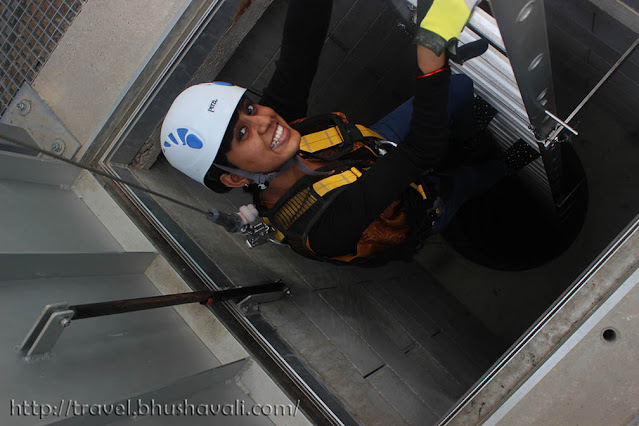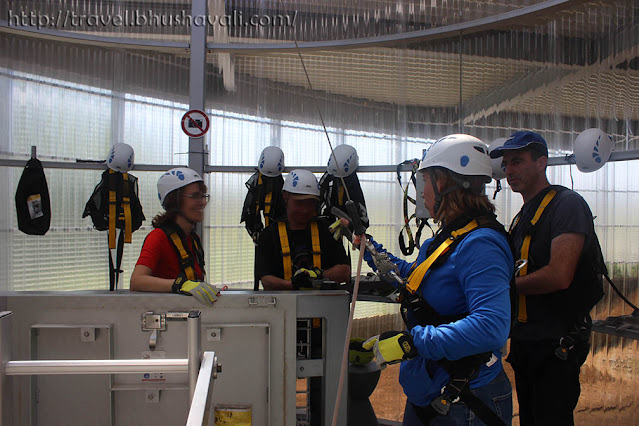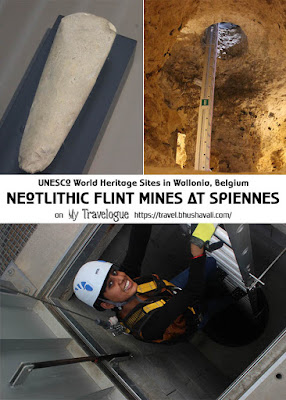MONS
BEST OF THE PLACES TO VISIT IN BELGIUM FOR HISTORY
ENTHUSIASTS
So, why did I mention that Mons in Magical in the last post on the
review of
Martin's Dream Hotel Mons? Why do I feel it is the Cultural Capital of Belgium? Well, Mons isn't
as popular as
Brussels or
Bruges, but Mons has a total of 8 UNESCO World Heritage Sites in and around it
(that's actually 4 in the UNESCO list, but individual sites counts to 8 -
read more about this count) plus 2 UNESCO recognized events, plus a UNESCO Memory of the World
collection as well. Let's begin this with the Neolithic Flint Mines at
Spiennes, in the outskirts of Mons.
VISITING SILEX'S (NEOLITHIC FLINT MINES AT SPIENNES)
I came to know of this place about 9-10 months back when I was in the
3rd trimester. The problem was then, pregnant women aren't allowed
here. Reason - that in the above pic. The mines are located 10 meters
underground which are only accessible with a ladder and with a big
bump in front of you, climbing down a ladder isn't really safe. Now, I
thought I could back carry her in a baby carrier and go down, but when
I went there I realized that wouldn't be safe either, and anyways, the
minimum age to enter the caves is 10! So Mr.V generously accepted to
stay above ground and take care of Atyudarini while I explored the mines!
UNDERGROUND TOUR OF NEOLITHIC FLINT MINES AT SPIENNES
I was accompanied underground by the guide Mr.Pierre, so all photos of me
from inside the mine were clicked by him! Here's him in front of a closed
mine (filled with the debris of another mine) in the 2nd last pic above. My regular readers would
know I always have an emotional attachment to pre-historic sites, may it
be
Anegundi, or
Dholavira or
Stonehenge... The very feel that our great great great grandparents walked those
very sites, ages and ages ago. This site is a Neolithic site meaning New
Stone Age, which is about 6000 years ago. Mining has happened in this site
from 4350 to 2300 BCE.
SILEX'S INTERACTIVE CENTRE (GROUND FLOOR EXHIBITION)
The car park is located a few metres away from the site and a ramp
reaches the actual mine site. To begin with, there is a detailed
explanation of what flints are (stones used to make weapons in
stoneage), the process of mining, the process of weapon-making, the
locations of various other similar sites etc.
WHAT ARE FLINT MINES?
Originally Flints were formed out of
compressed Sea Sponge & Silica of the cretaceous
era, which with time got became land, got compressed and dehydrated. The
sediment around it becomes chalk over time. Recreated samples of the flint
axes in various stages can be seen which end with a super polished stone.
I was told that to achieve that level of polished perfection takes about
8-20 hrs but in reality, it takes a couple months, as they weren't
full-time weapon makers, but had to do this in free time.
There are actually thousands of mines (tunnel-shaped burrows varying from
3ft to 10ft) in this region. Stone age men used to dig one mine at a time, from
the deepest point moving upwards, remove flint and in the process close it
up as well, before proceeding to make another tunnel. Sometimes these
shafts have galleries that are horizontal tunnels formed after reaching
the desired depth.
SILEX's NEOLITHIC FLINT MINES AT SPIENNES - UNESCO WORLD
HERITAGE SITES IN BELGIUM
There are several of these shafts in various depths. Though
nowadays these are interchangeably accessible, it wouldn't have been so
in Stone Age days. Today while the underground labyrinth is
interconnected, the access point is only through 1 mine (with
another mine serving as a ventilator). The rest are closed on the
surface.
As I mentioned earlier, the descent to the mine is using a 10m ladder
and is supported by a safety harness. The temperature underground is
maintained at 12°C and is dark at the beginning before they switch on
the lights. Yes, it was a bit amusing to wear helmet and safety gear
for a 10m depth (if you've done a bit of trekking or into active
holidays, you'd relate to this feel), but they have their rules to
follow. Obviously, pants and suitable shoes are required.
To preserve the place, the mine is open to only 36 people (12 x 3)
are allowed to descend into the underground mine every day so prior
booking is necessary via email/phone to Visit Mons. Also it is closed
in winters.
WHERE TO STAY IN MONS? - MONS HOTELS:
Mons Hotels and B&Bs at all price points are available in
Mons Town Centre.
Here’s my review of Martin's Dream Hotel where I stayed.
HOW TO REACH NEOLITHIC FLINT MINES AT SPIENNES
From Mons Railway station: 6km
Where is Neolithic Flint Mines at Spiennes - On
Google Maps: Silex's Neolithic Flint Mines
Nearest bus stop: Hyon Eglise served by the Mons town bus route
City'O Circuit
This is located 1.8km from the site and buses run every 15 mins
from Mons Station.
SILEX's NEOLITHIC FLINT MINES AT SPIENNES TICKETS
Individual entry ticket incl underground flint mines descent
(guided tour only): €14
Group entry ticket (upto 12 persons) only for underground
flint mines descent (guided tour): €95
Only 36 (12 x 3) people are allowed to descend into the
underground mines every day.
Reservation can be done via phone or email - +32 6533 5580
or groupes@ville.mons.be
GUIDED TOURS OF SILEX's NEOLITHIC FLINT MINES AT SPIENNES
Group visits are possible during weekdays in any language
(reservation required).
Visit for individuals is possible only during weekends. These guided tours are generally only in French. However, most guides speak other languages incl. Dutch, German, English etc. If you don't speak French it is better to inform them prior, so they can try to fit in a guide who knows the language.
Visit for individuals is possible only during weekends. These guided tours are generally only in French. However, most guides speak other languages incl. Dutch, German, English etc. If you don't speak French it is better to inform them prior, so they can try to fit in a guide who knows the language.
SILEX's NEOLITHIC FLINT MINES AT SPIENNES OPENING HOURS
Surface museum at Silexs is open only from April to November - Tue to Sun: 10AM to 4PM for surface visits
Surface museum at Silexs is open only from April to November - Tue to Sun: 10AM to 4PM for surface visits
Underground visits for individuals is possible only on weekends of April to November, to join one of the 3 tours (10:00AM, 11:30AM and 2:00PM)
UPDATE 2021 - Covid protocol for Individual visit to underground flint mines descentOnly one social bubble is allowed to descend at a time (people under a roof + 1 guest)Tickets - €4 per head + €95 for the guide.
There are 4 hiking routes near Neolithic Flint Mines in Mons incl. one that's really short 2.3km one that's suitable to go with a stroller / wheelchair. Here are the PDF maps of the 4 routes.
Grey Wagtail Walk - 2.3 km (stroller friendly)
Walk of the Blue Tit - 3.1 km
Walk of the Green Peak - 3.7 km
Walk of the Red Gorge - 5.4 km
Walk of the Red Gorge - 5.4 km
ON A DIFFERENT NOTE: If you're reading this post on your
email, you will continue to receive the new posts in your inbox, You are
free to unsubscribe any time. The link to unsubscribe can be found at the
end of your mail and your mail id will be removed from our Mailchimp Subscription list. If you came here via Facebook or Twitter or Pinterest or Instagram, and if you have liked/followed this blog's social media, you may
ofcourse choose to unfollow anytime. Rest assured your data is/will be
never shared or sold to anyone. You can read our Privacy Policy here for more information. You can always choose to revoke your
cookies through your browser settings. This information is towards GDPR Compliance.
MY COMPLETE MONS TRAVELOGUE (THINGS TO DO IN MONS)
Neolithic Flint Mines at Spiennes, Grand Hornu, Bois du Luc, The 4 boat lifts on Canal and Strepy Theiu, Mons Belfry, Mundaneum, Doudou Museum, St.Waudru Church,
Townhall, St.Elizabeth Church and other hidden spots!
MONS ITINERARY
Day 1 - Grand Hornu, Neolithic Splint mines at Spiennes
Day 2 - Bois du Luc, Ancient boat lifts & Strepy Theiu
Day 3 - City of Mons - Belfry, Mundaneum, Doudou Museum,
Beaux-Arts Mons etc






















Wooo! You made it to mines. I love mines and tunnels, one of weird attractions of mine. But yea, I like visiting and photographing weird stuff :)
ReplyDeleteWow. A great activity to do and never thought I’d this when taking into account a place like Belgium. You have surely enjoyed it and great for anyone looking fir more adventure driven activities. The mine shafts look interesting Thanks for sharing the details specially to a point where you have given details of accommodation near as well.
ReplyDeleteThis activity looks so fun! I've never experience mining before, just visiting a salt mine in Krakow. It's so cool to climb inside, see and touch it.
ReplyDeleteThis is awesome! I love UNESCO and historic sites. We always go out of our way to see them when travelling. Yes, sometimes they do go a bit over the top with safety but I guess they have their rules :-)
ReplyDeleteI’m from a traditionally mining community in South Wales so love all things mining! This looks like a really cool one to visit, and one I hadn’t heard of before! You must have been itching to go back after first going while pregnant. It’s probably a good job you didn’t carry your baby down too - I can’t even imagine carrying a bag down that ladder let alone an actual baby human!
ReplyDeleteWow! I knew Mons has some UNESCO heritage sites but had no idea they are so stunning! Thank you for sharing :)
ReplyDeleteThis is so cool. I have always been amazed with historical relics and artifacts. I would love to visit these place. Also, I am so thankful for all the effort that UNESCO is extending to protect all these heritage sites.
ReplyDeleteWhile reading your stay at Mons, I was expecting you to introduce some historic wonderful post once again. Wow you have personally visited mines which I never thought of. A real lifetime experience and it is good that Mr. V took care of your little one. It is good that this flint mine follow all safety procedures.
ReplyDeleteThat's such an incredible experience! I didn't know what flints are until your post. It is a good idea not to visit while you were pregnant - it didn't seem safe for you to climb that ladder!
ReplyDeleteI'm quite scared of heights so that ladder would be tricky for me, but I know I'd enjoy visiting the Neolithic flint mines. I love historical sites, and Mons is now firmly on my list. I just got home from Gent in Belgium this morning, so more Belgium is definitely welcome!
ReplyDeleteI have heard about Mons. I have a special interest in these world heritage sites of Europe. Now that this site has caught my attention, I would love to explore it.
ReplyDeleteThere are similar caves in Meghalaya in India with endless tunnels, I am yet to explore them but I am sure that the interiors will be of a similar style.
Bhushavali, The mines you talk of makes for interesting reading to know that folks back then spent 2 months of their daily free time in making a weapon/axe. Life was slow back then. So mines were dug to find this material only right? Don't think people could live here no?
ReplyDeleteSounds very exciting and interesting.
ReplyDelete